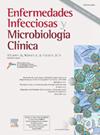Factors associated with glucocorticoid dosing in treating patients with noncritical COVID-19 pneumonia: Insights from an artificial intelligence-based CT imaging analysis
IF 2.5
4区 医学
Q3 INFECTIOUS DISEASES
Enfermedades infecciosas y microbiologia clinica
Pub Date : 2025-08-01
DOI:10.1016/j.eimc.2024.12.018
引用次数: 0
Abstract
Objective
Glucocorticoids are vital in treating COVID-19, but standard dosage for noncritical patients remain controversial. To determine the optimal glucocorticoid dosage for noncritical COVID-19 patients, we analyzed factors influencing dosage and developed a predictive model.
Methods
We retrospectively analyzed 273 noncritical COVID-19 pneumonia patients underwent pulmonary CT and treated with glucocorticoids in a tertiary hospital (12/2022–01/2023). Patients were divided into low and high glucocorticoid dosage groups based on a daily 40 mg methylprednisolone or equivalent. Artificial intelligence (AI)-based deep learning was utilized to assess pulmonary CT images for accurate lesion area, which then analyzed through multivariable logistic regression to explore their correlation with glucocorticoid dosage. A predictive model was developed and validated for dosage prediction.
Results
The primary analysis included 243 patients, with 168 in the training set and 75 in the validation set. High-dose treatment was administered to 139 patients (82.7%) and low-dose to 29 patients (17.3%) in the training cohort. A predictive model incorporating normally inflated ratio, ground-glass opacity (GGO) ratio, and consolidation ratio accurately predicted selection of high- or low-dose, in both training (AUC = 0.803) and validation cohorts (AUC = 0.836), respectively. In 30 patients with post-CT adjusted dosages, the predicted dosages highly matched with the actual adjusted dosages.
Conclusion
Glucocorticoid dosages for noncritical COVID-19 pneumonia treatment are influenced by pulmonary CT features. Our predictive model can predict glucocorticoid dosage, however, should be validated by larger, prospective studies.
非危重性COVID-19肺炎患者糖皮质激素剂量相关因素:来自基于人工智能的CT成像分析的见解
目的糖皮质激素在COVID-19治疗中至关重要,但非危重患者的标准剂量仍存在争议。为了确定非危重型COVID-19患者的最佳糖皮质激素剂量,我们分析了影响剂量的因素并建立了预测模型。方法回顾性分析某三级医院于2022年12月~ 2023年1月行肺CT并糖皮质激素治疗的非危重型COVID-19肺炎患者273例。根据每日40 mg甲基强的松龙或同等剂量将患者分为糖皮质激素低剂量组和高剂量组。利用基于人工智能(AI)的深度学习对肺部CT图像进行评估,获得准确的病灶面积,并通过多变量logistic回归分析其与糖皮质激素剂量的相关性。建立了预测模型,并对其进行了验证。结果初步分析纳入243例患者,其中训练组168例,验证组75例。在训练队列中,139例患者(82.7%)接受了高剂量治疗,29例患者(17.3%)接受了低剂量治疗。在训练组(AUC = 0.803)和验证组(AUC = 0.836)中,纳入正常充气比、毛玻璃不透明度(GGO)比和实变比的预测模型分别准确预测了高剂量或低剂量的选择。在30例ct后调整剂量的患者中,预测剂量与实际调整剂量高度匹配。结论糖皮质激素治疗非危重型COVID-19肺炎的剂量受肺部CT表现的影响。我们的预测模型可以预测糖皮质激素的剂量,但是,还需要更大规模的前瞻性研究来验证。
本文章由计算机程序翻译,如有差异,请以英文原文为准。
求助全文
约1分钟内获得全文
求助全文
来源期刊
CiteScore
2.10
自引率
8.00%
发文量
194
审稿时长
29 days
期刊介绍:
Hoy está universalmente reconocida la renovada y creciente importancia de la patología infecciosa: aparición de nuevos agentes patógenos, de cepas resistentes, de procesos con expresión clínica hasta ahora desconocida, de cuadros de una gran complejidad. Paralelamente, la Microbiología y la Infectología Clínicas han experimentado un gran desarrollo como respuesta al reto planteado por la actual patología infecciosa. Enfermedades Infecciosas y Microbiología Clínica es la Publicación Oficial de la Sociedad Española SEIMC. Cumple con la garantía científica de esta Sociedad, la doble función de difundir trabajos de investigación, tanto clínicos como microbiológicos, referidos a la patología infecciosa, y contribuye a la formación continuada de los interesados en aquella patología mediante artículos orientados a ese fin y elaborados por autores de la mayor calificación invitados por la revista.

 求助内容:
求助内容: 应助结果提醒方式:
应助结果提醒方式:


